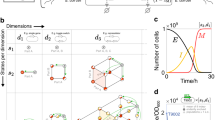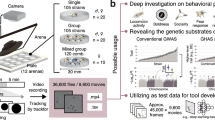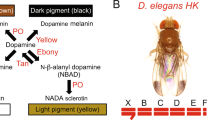Summary
Transposing genetic elements make up a significant proportion of the DNA of at least some eukaryotes. One of the potential side effects of transposition is a high rate of apparently spontaneous mutation. In this paper we consider some of the evolutionary strategies that might be involved in the suppression of transposition, and we outline a model for the control of spontaneous mutation in terms of the regulation of transposition. Specific predictions are based upon the well-characterized genetics of the mutator system associated with hybrid dysgenesis in Drosophila melanogaster, which has many parallels with the expected behaviour of transposing elements.
Similar content being viewed by others
Article PDF
References
Alexander, M L. 1949. Note on gene viability in natural populations of Drosophila. Univ Texas Publ, 4920, 63–69.
Ananiev, E V, Gvozdev, V A, Yu Ilyin, V, Tchurikov, N A, and Georgiev, G P. 1978. Reiterated genes with varying location in intercalary heterochromatin regions of Drosophila melanogaster polytene chromosomes. Chromosoma, 70, 1–17.
Auerbach, C. 1976. Mutation Research. Chapman and Hall, London.
Berg, R L. 1965. Studies of mutability in geographically isolated populations of Drosophila melanogaster Meig. Mutation in Population, Symposium on the Mutation Process. Prague. pp. 61–74.
Cameron, J R, Loh, E Y, and Davis, R W. 1979. Evidence for transposition of dispersed repetitive DNA families in yeast. Cell, 16, 739–751.
Cohen, S N, and Shapiro, J A. 1980. Transposable genetic elements. Sci Amer, 242, 36–45.
Crick, F H C. 1979. Split genes and RNA splicing. Science, 204, 264–271.
Dawkins, R. 1976. The Selfish Gene. Oxford University Press, London.
Doolittle, W F, and Sapienza, C. 1980. Selfish genes, the phenotype paradigm, and genome evolution. Nature, 284, 601–603.
Dover, G, and Doolittle, W F. 1980. Modes of genome evolution. Nature, 288, 646–647.
Engels, W R. 1979. Extrachromosomal control of mutability in Drosophila melanogaster. Proc Natl Acad Set, USA, 76, 4011–4015.
Farabaugh, P J, and Fink, G R. 1980. Insertion of the eukaryotic transposable element Ty1 creates a 5-base pair duplication. Nature, 286, 352–356.
Gehring, W J, and Paro, R. 1980. Isolation of a hybrid plasmid with homologous sequences to a transposing element of Drosophila melanogaster. Cell, 19, 897–904.
Golubovsky, M D, Yu Ivanov, N, and Green, M M. 1977. Genetic instability in Drosophila melanogaster: Putative multiple insertion mutants at the singed bristle locus. Proc Natl Acad Sci, USA, 74, 2973–2975.
Green, M M. 1978. The genetic control of mutation in Drosophila. Stadler Symposium, 10, 95–104.
Green, M M, and Shepherd, S H Y. 1979. Genetic instability in Drosophila melanogaster: The induction of specific chromosome 2 deletions by MR elements. Genetics, 92, 823–832.
Heffron, F, McCarthy, B J, Ohtsubo, H, and Ohtsubo, E. 1979. DNA sequence analysis of the transposon Tn3: Three genes and three sites involved in transposition of Tn3. Cell, 18, 1153–1163.
Henderson, S A, Woodruff, R C, and Thompson, J N, Jr. 1978. Spontaneous chromosome breakage at male meiosis associated with male recombination in Drosophila mlanogaster. Genetics, 88, 93–107.
Ising, G, and Ramel, C. 1976. The behaviour of a transposing element in Drosophila melanogaster. In The Genetics and Biology of Drosophila, eds. M. Ashburner and E. Novitski. Vol. 1b, pp. 947–954. Academic Press, London.
Ives, P T. 1950. The importance of mutation rate genes in evolution. Evolution, 4, 236–252.
Kidwell, M G, Kidwell, J F, and Sved, J A. 1977. Hybrid dysgenesis in Drosophila melanogaster: a syndrome of aberrant traits including mutation, sterility and male recombination. Genetics, 86, 813–833.
Leigh, E G, Jr. 1973. The evolution of mutation rates. Genetics (Suppl.), 73, 1–18.
McClintock, B. 1952. Chromosome organization and genic expression. Cold Spring Harbor Symp Quant Biol, 16, 13–47.
Mirzabekov, A D. 1981. Mobile genetic elements: new Soviet Studies. Nature, 291, 12.
Orgel, L E, and Crick, F H C. 1980. Selfish DNA: the ultimate parasite. Nature, 284, 604–607.
Orgel, L E, Crick, F H C, and Sapienza, C. 1980. Selfish DNA. Nature, 288, 645–646.
Potter, S S, Brorein, W J, Jr, Dunsmuir, P, and Rubin, G M. 1979. Transposition of elements of the 412, copia, and 297 dispersed repeated gene families in Drosophila. Cell, 17, 415–427.
Potter, S, Truett, M, Phillips, M, and Maher, A. 1980. Eukaryotic transposable genetic elements with inverted terminal repeats. Cell, 20, 639–647.
Roeder, G S, Farabaugh, P J, Chaleff, D T, and Fink, G R. 1980. The origins of gene instability in yeast. Science, 209, 1375–1380.
Shapiro, J A. 1979. Molecular model for the transposition and replication of bacteriophage Mu and other transposable elements. Proc Natl Acad Sci, USA, 76, 1933–1937.
Slatko, B. 1978. Evidence for newly induced genetic activity responsible for male recombination induced in Drosophila melanogaster. Genetics, 90, 105–124.
Spencer, W P. 1935. The non-random nature of visible mutations in Drosophila. Amer Naturalist, 69, 223–238.
Strobel, E, Dunsmuir, P, and Rubin, G M. 1979. Polymorphisms in the chromosomal locations of elements of the 412, copia and 297 dispersed repeated gene families in Drosophila. Cell, 17, 429–439.
Sturtevant, A H. 1937. Essays on evolution. I. On the effects of selection on mutation rate. Quart Rev Biol, 12, 464–467.
Thompson, J N, Jr, and Woodruff, R C. 1978a. Mutator genes: Pacemakers of evolution. Nature, 274, 317–321.
Thompson, J N, Jr, and Woodruff, R C. 1978b. Chromosome breakage: A possible mechanism for diverse genetic events in outbred populations. Heredity, 40, 153–157.
Thompson, J N, Jr, and Woodruff, R C. 1980. Increased mutation in crosses between geographically separated strains of Drosophila melanogaster. Proc Natl Acad Sci, USA, 77, 1059–1062.
Voelker, R A. 1974. The genetics and cytology of a mutator factor in Drosophila melanogaster. Mutation Res, 22, 265–276.
Williams, G C. 1966. Adaptation and Natural Selection. Princeton University Press, Princeton, N.J.
Williamson, V M, Young, E T, and Ciriacy, M. 1981. Transposable elements associated with constitutive expression of yeast alcohol dehydrogenase II. Cell, 23, 605–614.
Woodruff, R C, and Thompson, J N, Jr. 1980. Hybrid release of mutator activity and the genetic structure of natural population. Evolutionary Biology, 12, 129–162.
Woodruff, R C, Thompson, J N, Jr, and Lyman, R F. 1979. Intraspecific hybridisation and the release of mutator activity. Nature, 278, 277–279.
Woodruff, R C, Slatko, B E, and Thompson, J N, Jr. 1982. Factors affecting mutation rate in natural populations. In The Genetics and Biology of Drosophila, eds. M. Ashburner, H. L. Carson, and J. N. Thompson, Jr. Vol. 3c, in press. Academic Press, London.
Yannopoulos, G. 1978. Studies on male recombination in a Southern Greek Drosophila melanogaster population, (c) Chromosomal abnormalities at male meiosis. (d) Cytoplasmic factor responsible for the reciprocal cross effect. Genet Res, Camb, 31, 187–196.
Young, M W. 1979. Middle repetitive DNA: A fluid component of the Drosophila genome. Proc Natl Acad Set, USA, 76, 6274–6278.
Author information
Authors and Affiliations
Rights and permissions
About this article
Cite this article
Thompson, J., Woodruff, R. A model for spontaneous mutation in Drosophila caused by transposing elements. Heredity 47, 327–335 (1981). https://doi.org/10.1038/hdy.1981.95
Received:
Issue date:
DOI: https://doi.org/10.1038/hdy.1981.95
This article is cited by
-
Brief temperature stress during reproductive stages alters meiotic recombination and somatic mutation rates in the progeny of Arabidopsis
BMC Plant Biology (2017)
-
Molecular cloning and analysis of forked locus in Drosophila ananassae
Molecular and General Genetics MGG (1991)
-
Mdg-1 mobile element polymorphism in selected Drosophila melanogaster populations
Genetica (1988)
-
Copy-number dependent transpositions and excisions of the mdg-1 mobile element in inbred lines of Drosophila melanogaster
Heredity (1987)
-
Insertional DNA and spontaneous mutation at the white locus in Drosophila simulans
Molecular and General Genetics MGG (1987)



